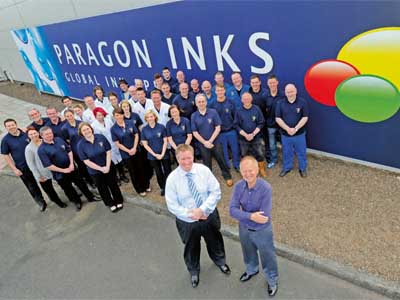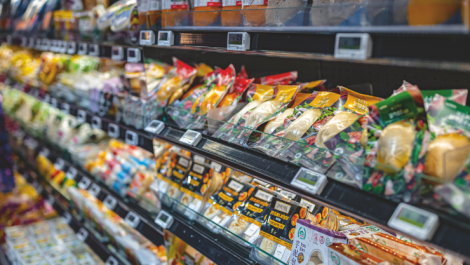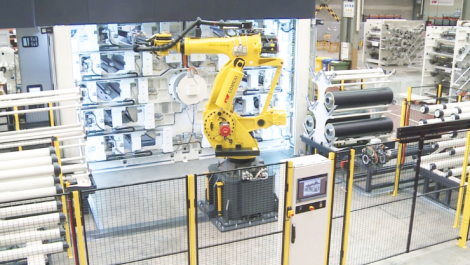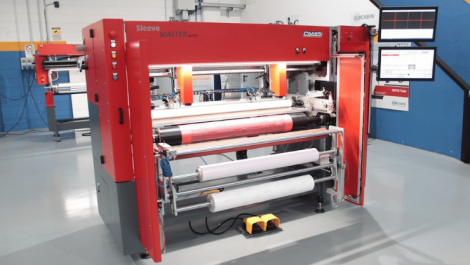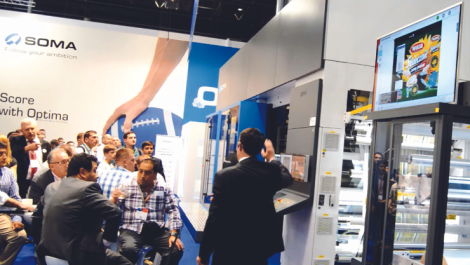The team at Paragon Inks
Underlying trends in the flexo market can be seen in the types of inks in use, from UV to water-based. Nessan Cleary talks to a number of suppliers.
The fundamental job of any ink is to carry coloured pigment to a range of different substrates from paper to plastics. The ink has to adhere to the surface, but these days it must also comply to increasingly strict health and safety standards. It must be easy to work with and not impede the smooth running of the press. And, of course, it must be cost effective.
All of this is challenging with any type of printing, but more so with flexo as this process covers everything from wide web packaging applications through to narrow web labels. Amanda Jones, UK and international sales manager at Paragon inks, pointed out that narrow web presses now use a wide variety of substrates from paper-based labels through to flexible films for pouches, saying, ‘We have to be familiar with the end converting, with how an in-mould label is going to be produced or a shrink sleeve is going to handle on the line. There has been a lot of change in our understanding of all the applications in developing the inks.’
The narrow web sector has embraced UV-curable inks in recent years, a trend that is continuing. Niklas Olsson, Flint Group Narrow Web global brand manager, said that adding UV curing to a press can be expensive but could double or triple the productivity and that this is leading many converters to invest in this technology. He said that UV is particularly suitable for some market segments, such as beauty and cosmetics because it is water resistant.
This is a sentiment echoed by James Whitehead, product manager for Fujifilm Graphics Systems, who noted that UV inks give very high resolution, which is a requirement of many labels that contain a lot of fine text. This is mainly because the UV inks cure immediately so they are easier to handle and there is less dot gain.
Fujifilm has developed UVivid Flexo JD, a high gloss ink system suitable for self-adhesive labels, sachets and pouches as well as low shrink sleeves. It is available as Pantone, process or metallic colours. Mr Whitehead said, ‘We tend to get high colour concentration so we can run a four colour process at lower anilox volumes with lower ink deposits for higher run lengths. Because we put down a lower amount of ink, there’s a thinner ink film and you don’t suffer from dot spread too much.’
Although most flexo inks are supplied in a choice of four colour sets and Pantone colours, Mark Bowman, managing director of ColorGen, said that seven colour process sets are also becoming popular. He explained, ‘The idea with seven colours is that you are not buying any spot colours that will always come at a premium. With seven colours you’ve a good chance of achieving the vast majority of any colour gamut.’
ColorGen mainly concentrates on UV inks for flexo. The standard range is TX, which is typically used on self-adhesive labels and some carton products. There is a variant, TX 7, with much higher colour strength designed to work with low volume anilox.
There is also a low volume system, LMA, which is also a high colour strength range.
In contrast, Pulse Roll Label Products has developed a range of UV fluorescent inks. These are designed for general label printing to help products stand out on a shelf. Pulse claims increased colour strength, allowing lighter aniloxes to be used whilst achieving the same density, as well as showing a smoother lay, resulting in a higher quality label. Sarah Harriman, marketing and communications manager, said, ‘This new range of inks offers bright and clean fluorescent effects, providing a solid eye-catching colour which will enhance the label and draw attention to the product.’
Opaque white
Several vendors have recently improved their opaque white flexo inks. There is an obvious need to have an opaque white, particularly for label applications, such as for putting a barcode on a translucent label, but it is difficult to produce a very dense white capable of printing in a single pass, so most ink manufacturers have had to develop a specific product.
Many converters are still screen printing the white backing, but as Mr Whitehead explained, ‘If you use rotary screen printing then it’s expensive and can take a long time.’ Thus Fujifilm has developed UVivid Supernova White. This gives a single pass opaque white with a high volume anilox for a printed result close to that of a screen white. Mr Whitehead added, ‘This gives you the durability and reusability of a flexo plate which is cheaper and faster than rotary screen.’

Fujifilm’s James Whitehead
ColorGen also has an opaque white which was launched last year. Mr Bowman said, ‘We are seeing a massive uptake in the market for that right now. We have a low migration version and a shrink sleeve version.’ He said that it has taken a while for ink manufacturers to find the right materials to convince converters to switch from using a screen process, but said, ‘I think we are probably as close as we are ever going to be now.’
LED curing
There is general agreement that the next step forward in UV inks is to replace the conventional curing lamps with light emitting diodes (LED). Amanda Jones said that UV LED curing is still in its infancy but that it will become more widespread as newer presses take it on board. However, UV LED curing only works if the photoinitiators in the ink have been tuned precisely to this type of curing. UV LED inks do tend to be slightly more expensive than conventional UV inks, but Mr Olsson pointed out that LEDs can dramatically reduce the power consumption of a press – by up to 80%. He explained that part of this saving comes from the fact that the LEDs turn on and off immediately with no need to wait for the lamps to come up to temperature or to cool down. This can lead to up to 15% increase in productivity, itself enough to justify the added costs of the inks.
Mr Olsson added that Flint is now concentrating up to 80% of its development on UV LED technology. So far it has only developed these inks for narrow web presses as the early inks were not stable enough for the demands of packaging print across a wide web, but the company is testing newer inks now, explained Mr Olsson, ‘We are looking at low migration packaging inks planned for later this year.’
For now, Flint has developed a range of EkoCure inks for narrow web presses with UV LED curing. One of the most recent additions to this range is a new set of Opaque White inks for use on shrink sleeves, which Flint says can cope with over 70% shrink. The EkoCure range also includes UV LED curable coatings, with various options such as gloss, matte and a non-yellowing coating as well as several primer coatings.
Low migration
Another big issue is that of low migration inks, with many vendors developing these inks, which are ostensibly for use with food packaging. Mr Bowman said that the market is moving towards low migration inks, explaining, ‘People won’t always want to carry two or three different product ranges. So even if they are not a food packaging producer, they will end up using low migration inks for a degree of compliance.’
The low migration inks tend to be 10-30% more expensive than standard inks though this may come down through economies of scale as more and more converters switch to them. But Mr Bowman said that this cost may be acceptable in order to rationalise products and simplify their inventory management. He added, ‘If you have the higher colour strength then maybe you will be using a bit less ink.’
However, there is no simple definition of what a low migration ink is, and so there is considerable variation from one product to the next. Mr Bowman said, ‘We try to provide packaging printers with a product range that we know will be low migration-compliant so far as their packaging is concerned.’ But the level of compliance required varies according to the application. Mr Bowman continued, ‘It’s relatively easy to provide a label printer with low migration ink that is going to be compliant for a low cost, but at the other end of the spectrum you have a someone printing flexible film packaging and needing the highest standard of low migration ink that money can buy.’
Of course, the only way to be sure that the ink really is suitable for a given use is to have the printed packaging analysed properly, preferably over a period of time to test consistency between batches.
Thus ColorGen will tweak the ink so that it matches the requirements of the packaging, which Mr Bowman said is easier for a small supplier as they tend to work more closely with customers.
Flint has added custom designed metallic silver and metallic pastes to its range of low migration inks. This includes Low Migration UV Flexo Silver, a single-component metallic UV flexo ink which should be able to achieve migration levels below 10 ppb when correctly applied on suitable packaging structures. Flint has also introduced three metallic pastes - Rich Gold, Pale Gold, and Silver – which are meant to be added to low migration ink systems, such as the UV curable Flexocure Ancora inks.
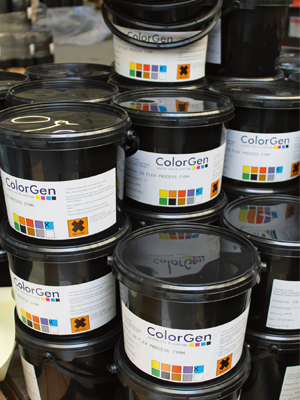
Inks from Haverhill-based ColorGen
Wide web flexo
The situation is somewhat different with wide web flexo presses where the market is mainly split between solvent and water-based inks. Amanda Jones said that it all comes down to a balance between cost and performance, noting that ‘solvent-based flexo is not just about the lower price of ink but also the hot air dryers and the additives.’ She added that the industry has not really accepted UV for wide web presses yet. She continued, ‘We would like to see more water-based out in the solvent market, but it’s all about performance. The cost is the same but the solvent has better performance.’
This is a sentiment echoed by Ian Firman, technical consultant with Van Son Ink UK Ltd, who said, ‘The advantage of water based is that there are no nasty nitrocellulose varnishes and there is no health and safety issues and no vapour release from the ink when they are dry.’
Van Son concentrates its efforts on water-based inks, having abandoned solvent inks some years ago. Water-based inks work well with paper substrates, so Van Son mainly targets envelope, paper bags and corrugated printers, though its inks are sold in the UK through Horizon.
Mr Firman said that Van Son inks are known for their consistency, adding, ‘We see our inks as very high in pigment strength and with very good press performance and stability.’ All the AquaBase+ inks use a very strong dispersion for colour which are then mixed with different application and technical varnishes and additives to give each ink product its specific characteristics and to target different substrates.
Solvent inks are still widely used for printing to plastics, though Mr Firman said that it is possible to print to some polyethylene ‘to a degree.’ He adds that solvent will continue to be the default ‘until we can get the same speed and the same lay down.’ He went on to say that progress continues to be made in this area.
hubergroup has developed a couple of new solvent-based inks. Thus Gecko Platinum promises good adhesion to a wide range of films, with high colour strength and is resistant to aggressive compounds, all with very low solvent retention. Richard Birch, technical director hubergroup UK, said that it is aimed at products such as coffee packs, food pouches and ready meals.

UV ink from Paragon Inks
The company has also developed Gecko Vantage for use with shrink sleeves for the flexo market. Mr Birch said that shrink sleeves have been dominated by gravure printing but added, ‘By switching to a modified NC ink system and a change of solvents to more alcohol rich these designs can now be printed flexo.’ It is suitable for paper as well as PVC and primed films.
Mr Birch said that the government’s desire to impose a 5p tax on carrier bags (due to come into effect in October this year) offers an opportunity to flexo ink manufacturers to print to biodegradable or compost grade plastic bags, which would be exempt. hubergroup has both water-based Aquaflex and solvent-based Gecko Frontal Eco inks with OK Compost and Vincotte certification. He said that although there would be an increase in production cost this would far outweigh the cost to the end user.
Mr Birch also said that there is an opportunity within the fresh foods market due to the success of the paper-like film structures that has enabled converters to switch from a mixed waste stream to a single ply recyclable alternative. He concluded, ‘Surely the next step would be to switch from standard films to renewable or biodegradable and aim to be one step ahead of legislation?’
Conclusion
Most ink manufacturers expect to see greater use of UV curing in wide web presses, because of the improvements to image quality and to productivity. But the investment cycle is much longer with wider web presses and the UV ink is four to five times more expensive than solvent or water-based inks. At the same time, we are bound to see further improvements in water-based ink technology that would allow it to work with a with a wider range of substrates but there is still plenty of interest in solvent-based inks despite the continued threat of legislation to reduce the use of solvents.

